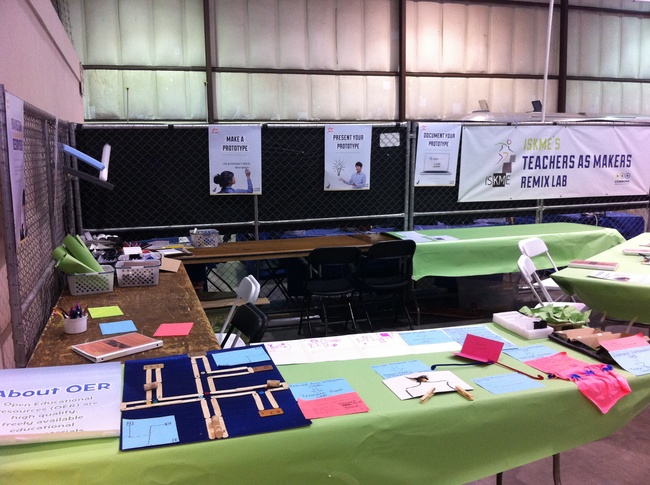ISKME's Teachers as Makers Remix Lab 2013
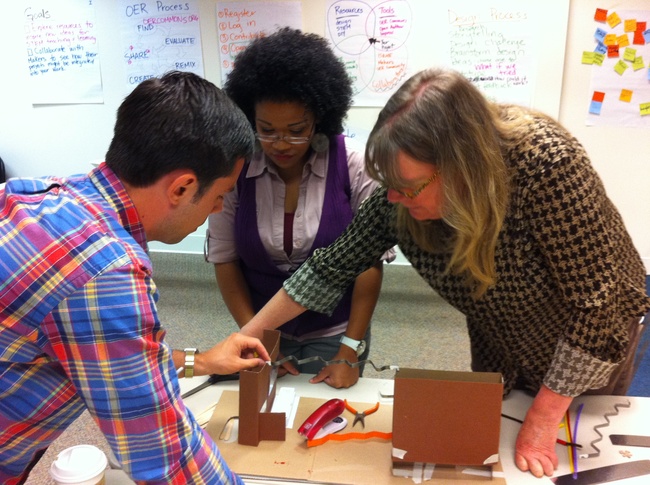
Description
Join ISKME as we remix Open Educational Resources (OER) using design thinking principles to create activities for innovative teaching and learning. We’ll showcase OER that explore such topics as environmental sustainability, arts integration, and storytelling, and lead teachers through a design process to research, brainstorm, prototype, present and get feedback, and refine their remixed activities. The activities will be documented online using Open Author on OER Commons and freely available for anyone to access and use.
Featured OER to be remixed:
Sustainability - Sun Curve Design Challenge: http://www.oercommons.org/courses/sun-curve-design-challenge-design-process-activity/view
Storytelling – Scrapbook: http://www.oercommons.org/courses/our-rights-of-the-child-scrapbook/view
Materials
Display:
- 5 share out boards
- 50 magnets
- 1 banner
- 4 design lab posters
- 5 table cloths
Design Table:
- 10 4x7 stickie pads
- 20 markers
Prototype Table:
- 5 boxes prototyping materials
- 20 rolls of tape
- 5 staplers
- 5 bottles of glue
- 5 scissors
Documentation Table:
- 1 flipcam
- 1 laptop
Set Up
Four 6' rectangular tables for display, brainstorming, prototyping materials, and documentation
One 4' round table for building prototypes
Design Lab Process
Design Lab Process Video OER from WGBH on OER Commons
Step 1: Identify the Challenge
Remix an OER Overview: Open Educational Resources (OER) are teaching and learning materials (lesson plans, courses, assignments, activities, labs, etc.) that are freely available to use, adapt, reuse, or share. Our goal with OER is to help transform teaching and learning by creating equitable access and sharing among educators and learners. Participants at Maker Faire will contribute to the OER movement by remixing (modifying, adapting, changing) and sharing OER that they can use with their students. Each participant will choose an OER to remix. They will brainstorm ways to remix the OER to meet their learner’s needs, such as the various grades, subjects, and learning styles. Once they have an idea they would like to move forward with, they will get prototyping materials to create a 3-D model of their idea. When their design prototype is complete, they will give it a title and description and present it in the Media Lab. Then they will hang their sketches on the share out boards with the title and description of their OER.
OER Remix Example
Original OER: UN Convention on the Rights of the Child Lesson Modules
Remixed OER: Our Rights of the Child Scrapbook - remixed for English High School students and project-based. The students create a woven scrapbook exploring visual arts and weaving different writing genres: poetry, narrative, expository/informative and argumentative/persuasive. In prepartion for the book students will need to address literacy, rights and self advocacy. This lesson will pull into current events in the local community and make connections to global scale. As an extension teachers can digitize pieces from the individual books and tie into a longer documentary piece.
Step 2: Brainstorm Ideas
Directions for participants:
1. Choose an Open Educational Resource (OER) to remix.
2. Draw and label ways to remix the OER to localize it to meet your learners' needs, such as the various grades, subjects, and learning styles.
3. Choose one design idea to prototype.
Give each participant a large stickie and markers to document their design ideas using words and drawings.
Once participants have an idea or ideas they would like to prototype (create a model of) they are ready to select prototyping materials.
Design Brainstorming Guiding Questions:
- What are subject(s) would you like to focus your remix?
- What type of pedagogy (teaching methods and styles) would you like to use in this remix?
- What materials and resources would you need to teach this OER?
- What would your design for the remixed OER look like?
- How would you structure the OER?
- Where would you teach this OER?
- Who would teach this OER?
- Who would the students be (grade, age, learning style, etc.)?
- How would the students learn/experience this OER?
- What would you rename your remixed OER design?
- How would your remix connect to the local community?
- Who would participate in your remixed OER (students, other educators, parents, community members, etc.)?
- How will this OER meet your student's needs?
- How is this OER connected to your greater goals as an educator and your school/organization/community goals?
Step 3: Select Prototyping Materials
Directions for participants:
Once you have a design idea to move forward with, select your prototyping materials.
Prototyping materials include: pipecleaners, popsicle sticks, papertowel rolls, cardboard, foam pieces, corks, plastic containers, fabric, tape, glue, bottle caps, lids, and various salvaged materials from RAFT
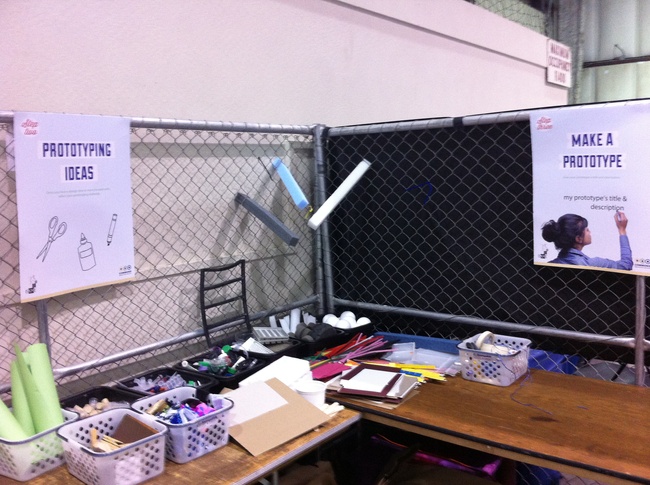
Step 4: Build a Prototype
Directions for participants:
Give your prototype a title and description.
Once each group has the materials they need to build their prototypes, they can work together to make their idea come to life with a 3-D model representation of their idea. Once their design prototype is complete, give it a title and description.

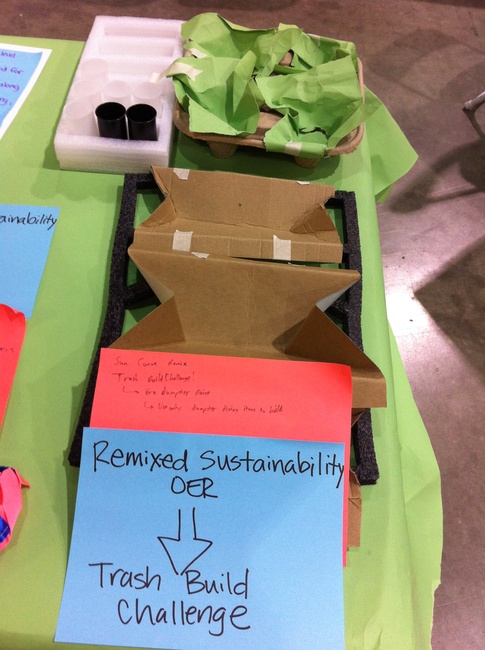
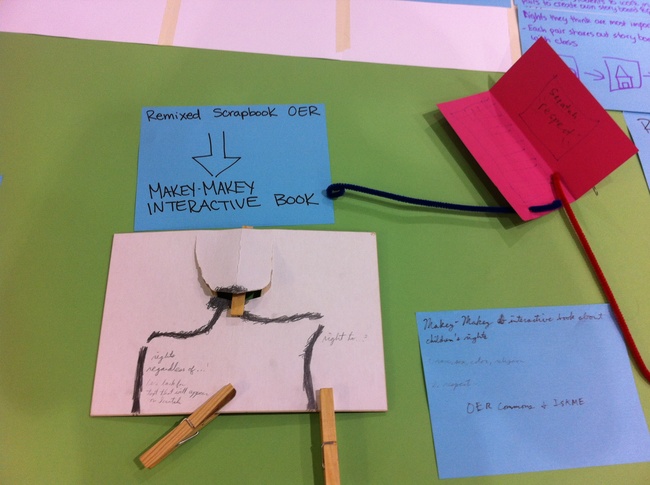
Step 5: Present Your Prototype
Directions for participants:
We will record your presentation of the prototype.
Use the flipcam to record their presentations in two minutes or less.
Video presentations:
Trash Build Challenge: Remixed Sun Curve Design Challenge where students use repurposed materials to build planters.
Makey-Makey Interactive Book: Remixed Rights of the Child Scrapbook where students create an interactive book using makey-makey electronics.
Treasure Hunt: Remixed Journaling Activity where students create a treasure map using shapes as landmarks.
Step 6: Document Your Prototype
Directions for participants:
Use Open Author on OER Commons to document your remix.
